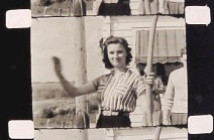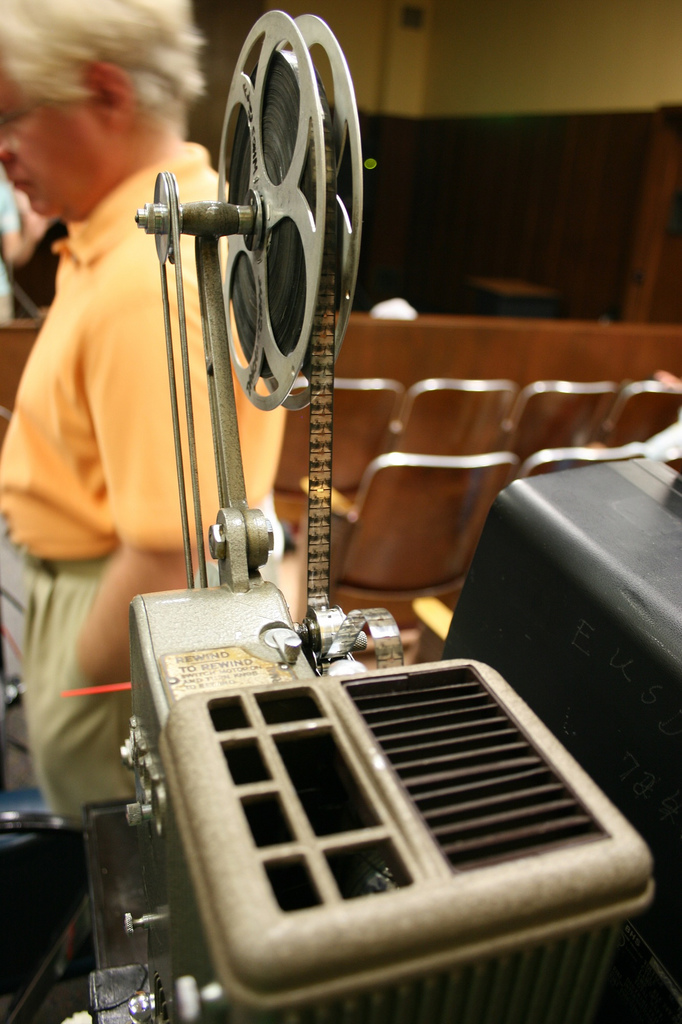Thanks to Skip Elsheimer for his report on the Raleigh Home Movie Day Event.
Below is the report. In general, we had more volunteers and less attendees
this year, but that allowed us to watch more films that folks had brought.
We were so enthralled with the Kodachrome 16mm films that one woman brought,
we convinced her to go home and bring back more reels.
Everything ran very smoothly, in spite of me bringing in a wretched Kodak
presstape splicer to do 8mm splices. Can anybody suggest a better 8mm tape
splicing solution?
Event venue: North Caroline State University Caldwell G107
Event time (screening): 1-4pm
Even time (inspection): 1-4pm
Total audience: 45 (including volunteers); 28 without
Number of people bringing in films: 10
Number of films screened by gauge:
8mm: 21
Super 8: 4
16mm: 14
9.5mm: none
Video: none
Volunteers: 17
Volunteer Names: Skip Elsheimer, Germaine Fodor, Marsha & Devin Orgeron, Charlotte Walton,Mark Koyanagi, Kate Klutz, Paul, Ora Gelley, Bob Pence, Jim Alchediak, Arthur Hailey, Lisa & Ben Carter, Jerry Pemberton, Zach Finch, Danica Cullinen.
Special events/screenings: after HMD, event at the NC State Archives on October 23rd
Press: News 14 interview with Skip Elsheimer, Our State magazine profile, small blurb in Raleigh News & Observer Friday edition and in Raleigh’s Independent Weekly.
Home Movie Day 2007 (super 8)
B&W super 8 film of the previous year’s Home Movie Day.
Cathy’s birthday party (mcdonalds) (8 mm)
Cathy’s 5th birthday in 1955. Germany. Done by uncle in service. Rest of film in fifferent place
Wedding and Christmas time.(McDonalds?) (8mm)
1950s filming outside then inside at wedding table.
Sally’s 16mm
1941 film of Belmont NC, aerial footage, Peace college. Little girl in fairy costume at Peace college. Aerial shots are from a race between Belmont and Asheville NC
McDonalds: Chuck and Jeff (16mm)
Dover, Delaware? Looked like Germany. Cute footage of kid in bib overalls with dog. Footage of family in Burlington, NC.. footage of girl in a plaid dress playing with a corgi “the girl from Dover”
‘41 Beach Frankie, Dell, Reed. Myrtle Beach (16mm)
Cute ducks (audience reaction: awww), cherry blossoms; beach footage, frolicking; kids on swing (audience laughter); series of poses by little girls and hopping
Audience highly entertained.
Joseph & Alexina 50th anniversary (8mm)
Dim. crowd milling at lake; lake shots; folks milling about house & garden. Jump cut to snow. (Massachusetts?) More cold weather shots; mass at school. Christmas with fancy tree (“wow”s from audience); hilarious woman pointing at angel on mantel; more Christmas décor; more heavy snow
1943 wedding/summer/swimming/picnic
Julia & Pitney Stowe wedding (8mm)
Pitney in uniform; Mr. SP Stowe, textile man w/hearing aid; folks swimmin’; another cute kid.
Kate Klutz – Faith, NC, 4th parade, films by her brother w/Kate’s marching band (8 mm)
Umbrella Hat!!!; rebel flag; civil war guys; lots of good parade moments; clowns, American Legion, marching band, flag girls, Crescent Cloggers (big hit); classic cars
McDonald’s (8mm)
Kid doing the dead man’s float, snow on the ground. skiing
First film production class taught 1979 (super 8)
Speech communication department. Audio! Classroom filing up with students, film shown, back to lecturing. Was using an intervalometer (3 frames per second). Chinon camera.
Family film-maybe taken by grandfather or mother (super 8)
Group getting on bus, Europe. Filming from moving vehicle shot of everyone sleeping on the bus, barge on water, great footage of landscape from boat. Audience member identified The Rhine Bavaria (?). shots of French farmer’s market in town, Belgium? Switzerland? Graveyard with people creeping around, cuts to some castle then Versailles. Guy drinking on deck, flower gardens, Europe, aerial (or mountainside?) shot of farmland, cows, bird flying
McDonalds’ Burlington Christmas (8mm)
Shiny new bicycle, globe, typewriter? Gumball machine, viewfinder
Cary’s 4th and Chip “bath” (8mm)
Christmas time, someone got a guitar, ,a good snow outside in AtwaterCalifornia. Dog chasing snow, dancing, barking.
Marilyn’s dad (Niagara falls?) 16mm
1950s footage of falls, family posing in front,
Ron’s family 16mm
Watched upside down and backwards. Jumping in lake, sitting lakeside
Jim’s 1987 animation class project (super8)
Man watching TV, old commercials, mouth shows up on guy’s stomach, then he makes pillsbury’s cookies and two pieces of dough turn into eyes horrified by the fate of the dough. We couldn’t see the rest (due to splices breaking) but Jim told us that the cookie eyeballs roll onto the floor and gather themselves and roll away.
1953 Marilyn’s first trip to Niagara Falls (16)
Marylin’s grandma was there, Marylin’s dad probably shot the film. The falls, horse and buggy ride.
Buffalo NY (8mm) “Children” 1958
Twins in baby pool, kids in lake, pony rides,
Morehead 1958 (16mm)
Camp Morehead at Morehead City, NC. Archery, knuckleball, sailboats, camp is now a housing development. Kids sailing at Bogue sound.
Buffalo “Wedding” (8mm) (Peg & Frank)
lilac bush; folks preparing outdoor food; rice throwing; twin flower girls; decorated car
Sally: ROTC commission ‘66 (16mm)
Davidson College; outdoor ceremony; band conductor gets a laugh
Kate Klutz – farm, Pyramid, Wendy (8mm)
Artfully lit cat; Kate’s sister & brother-in-law; glimpse of pyramid house!!!; folks in pool; tiny shaggy donkey; goats
Briarcliff (Myrtle Beach) 1949 (16mm)
Crabbing & fishing: Tommy & Johnny as boys;
Marching band ‘61; Thanksgiving or Xmas (8mm)
Youngstown: Marching band at night; big dinner; parade
1944 Tommy Hunter (16mm)
Birthday party w/little kids
K Klutz: ? Raleigh & Kitt Creek Rd – Cisco Campus (8mm)
Mid-80’s: CharGrill in snow! Monster Truck; state Capitol grounds; historical monuments; chicken hugging out at Cisco Campus; other fowl.
1942: snow Martha and Adele 8mm
Girls with balloons & swing; reversible race doll; snow-covered manor in Belmont. Kids in snow, eating snow.
1960 Marilyn graduates Youngstown Ohio 8mm
Women in white, men in black. Principal Mr. Parenti. Marilyn is valedictorian, speech upsets the John Birch society. Footage of tossing caps and folks running. Ohio University parade/homecoming. Big John (jfk), feet, roadrunner float.
1947 Ann and Ray at Silver Springs, Hunter at Charleston 16mm
Swimming, lounging-on a riverboat-cuts off.
Kate Klutz carnival 8mm
Footage from moving vehicle, Faith 4th of july fair. Rides: octopus, swings,
ferris wheel, caterpillar, footage taken from ON the ferris wheel
More Marilyn Ohio University parade 8mm
Floats: punch card computer, dachsund circling fire hydrant, smoking frog,
“sneak up on the reds”, preying mantis “prey on Miami”, lots more floats, marching band
Beach 1944 16mm
Jumping waves, cuts to same kid at sandbox, inland home
Klutz 1988 Red and Blue Pyramid 8mm
Sunbathing by the above ground pool, screen porch that joined the two pyramids. Blue pyramid they lived in, playmobile figurines lined up, pokey, a smurf, pyramids seen from a distance. Faith 4th of July parade, carnival set-up
Marilyn’s dorm Ohio U 8mm
Pair of suited men walking on Ohio U campus, Jefferson Hall, cleaning a classic car, Marilyn’s house, carving a turkey,
16mm May 1945 Tommy 7
Park/lake, Tallahassee beach, back to park
Flood of Tom Bigby River (1945) Columbus, Mississippi (8mm)
Shot by grandfather: b&w deep flood waters; kids & dog posing
New Orleans & State Park 1947 (8mm)
Street scenes; kids posing in their Sunday best; kid mowing lawn; playground
16mm May 1947 Johnny walking
Three kids, one is Johnny, scooter, football laughs
St. Ignes/Castle Rock, MI (8 mm)
Nice landscapes, upper peninsula looking at lower peninsula; cute kids; lakeside fun



